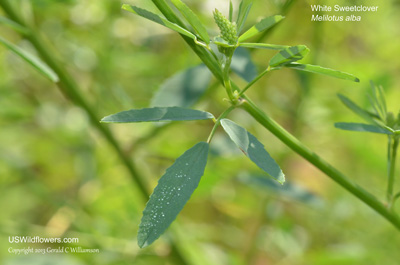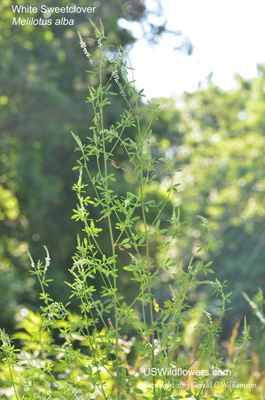Wildflowers of the United States | |||||||||||||
| |||||||||||||
Melilotus albus - White Sweetclover, White Melilot, Honey-Clover, Bokhara Clover. This plant is a native of Eurasia, from the Mediterranean to Tibet. It appears nearly identical to Melilotus officinalis except for blossom color. Some authorities consider them to be separate species rather than color forms of the same species because they are reported to be genetically incompatible. USDA Plants Database has synonymized M. albus with M. officinalis, but ITIS, Weakley, the USDA Forestry Service (FEIS), and others continue to treat them separately. In addition to the color difference, the blossom of M. albus is somewhat smaller. Because USDA Plants database has them synonymized, the map shown here is that for M. officinalis, and my guess is that this is a combined map of the two species. I expect that the distribution of these two species is similar - one or the other (or both) is found in every state in the United States, and almost all of Canada.
| Melilotus was reported in the United States as early as 1664, and by 1817 it had spread as far west as Utah and Nevada. It was reported in Alaska in 1916, and in Hawaii in 1920. Its spread was largely because it was promoted for soil reclamation, both for improving soil quality from worn-out tobacco fields and for stabilizing eroding hillsides. It was also planted for honey production and as a livestock and wildlife forage. It was used for soil reclamation by federal agencies as recently as 1998. Having escaped and naturalized, it grows in a variety of habitats, and is reportedly more invasive in northern temperate climates than in southern. Found in: AK, AL, AR, AZ, CA, CO, CT, DC, DE, FL, GA, HI, IA, ID, IL, IN, KS, KY, LA, MA, MD, ME, MI, MN, MO, MS, MT, NC, ND, NE, NH, NJ, NM, NV, NY, OH, OK, OR, PA, RI, SC, SD, TN, TX, UT, VA, VT, WA, WI, WV, WY   Blue=Native; Grey=Introduced Map from USDA Plants Database: USDA, NRCS. 2017. The PLANTS Database (http://plants.usda.gov, 26 Apr 2025). National Plant Data Team, Greensboro, NC 27401-4901 USA. Search Our Database: Enter any portion of the Scientific, Common Name, or both. Do a general Google search of the entire site: #ad
| #ad
| | ||||||||||
|
Commercial / Cookie Notice Looking for Wildflowers for a specific state? Check here: | |||||||||||||
|
| |||||||||||||



